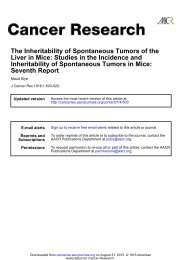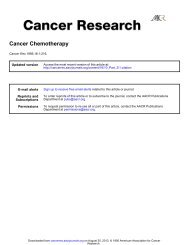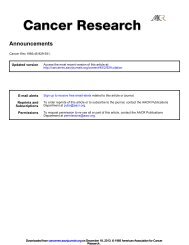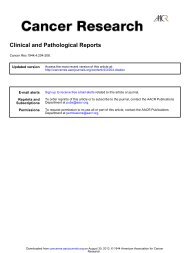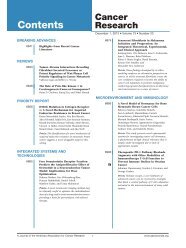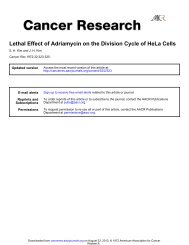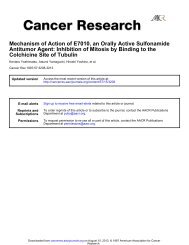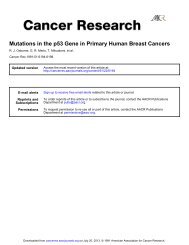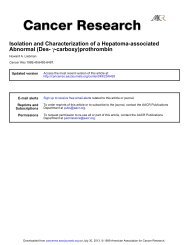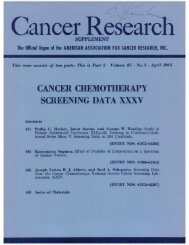Trichothiodystrophy, a Human DNA Repair ... - Cancer Research
Trichothiodystrophy, a Human DNA Repair ... - Cancer Research
Trichothiodystrophy, a Human DNA Repair ... - Cancer Research
Create successful ePaper yourself
Turn your PDF publications into a flip-book with our unique Google optimized e-Paper software.
Cell Culture. The fibroblasl cell strains used in our experiments were<br />
all established from skin biopsies in our own or other laboratories.<br />
They are listed in Table 1. Cells were maintained in Eagle's minimum<br />
essential medium supplemented with 15% fetal calf serum. To bring<br />
them into a state approaching quiescence, they were plated in complete<br />
medium, which was replaced the following day with medium containing<br />
0.5% serum. The cells were then incubated for at least 2 days prior to<br />
experiments. Although not all of the population will have completely<br />
ceased dividing after 2 days, for brevity we refer to such populations as<br />
nondividing.<br />
Cellular Responses to UV. Procedures for cell culture (13), cell<br />
survival (14), mutation (15). UDS(16), recovery of RNA synthesis (17,<br />
18), stationary phase survival (17), and complementation (12) following<br />
UV irradiation are routinely used in our laboratories and have all been<br />
described previously. For determination of SCEs exponentially growing<br />
cells were UV irradiated and cultured for two cycles (44-50 h) in the<br />
presence of 5 JJM bromodeoxyuridine. The cells were processed as<br />
described previously (19). Measurement of repair replication using<br />
alkaline CsCI gradients followed the procedure of Smith and Hanawalt<br />
(20). UV endonuclease-sensitive sites were assayed in permeabilized<br />
cells by the high-salt procedure of van Zeeland et al. (21). For measure<br />
ment of incision breaks 2 x 105normal cells and TTD cells were labeled<br />
with 0.05 nCi/ml ['"qthymidine (50 mCi/mmol) and 5 ¿iCi/ml['Hj-<br />
<strong>DNA</strong> REPAIR DEFECT IN TRICHOTHIODYSTROPHY<br />
thymidine (2.5 Ci/mmol), respectively. The following day the medium<br />
was replaced with fresh medium containing 0.5% fetal calf serum. After<br />
a further 2 or 3 days of incubation, the cells were incubated for 30 min<br />
in 0.5% serum medium containing 10~2M hydroxyurea. IO"4M \-ß-o-<br />
arabinofuranosylcytosine, UV irradiated, and incubated for a further<br />
30 min in the presence of the inhibitors. Cells were then scraped off<br />
the dishes into 0.2 ml 0.02% EDTA in buffered saline, the "C-labeled<br />
normal cell suspension was mixed with the 3H-labeled TTD cell sus<br />
pension which had been exposed to the same treatment, and 150 ^1<br />
were lysed on top of alkaline sucrose gradients which were subsequently<br />
centrifuged at 30,000 rpm for 60 min. Fractions were collected and the<br />
radioactivity measured as described previously (22).<br />
RESULTS<br />
We have examined the responses of TTD cells to UV irradi<br />
ation using several different assay systems.<br />
Patient 1. The responses to UV light of cell strain PI were<br />
normal in all assays in which they were tested, as shown by the<br />
filled inverted triangles in the figures. Thus cell survival (Fig.<br />
1), mutability (Fig. 2A), and SCE induction (Fig. 2B) were all<br />
similar to those in normal cells. The spontaneous and induced<br />
usedPhenotype<br />
strainsNormal<br />
Table 1 Cell strains<br />
Cell<br />
IBRGM73048BRVHKBSBTTD<br />
TTDIGL(PI)TTD2GL<br />
(P2)TTD3BI<br />
(P3)TTD3PVTTD4PVCS<br />
CS1BOCS1BRCS2BEXP<br />
XPIBR (D)°XP5BRXP2BI<br />
(G)XP2RO<br />
(E)XP9PV<br />
(C)XP25RO<br />
(A)XP4LO<br />
(A)Ref.667742164344454414"<br />
Letters in parentheses, complementation groups.<br />
l 23456<br />
UV.DOSE Um2!<br />
o IBR<br />
T PI<br />
P2<br />
•P3<br />
A TTD4PV<br />
O CSBO<br />
n CS1BR<br />
XPIBR<br />
A XP5BR<br />
V XP2BI<br />
Fig. 1. Cell survival in TTD cells. Colony-forming ability of growing cells UV<br />
irradiated with different fluences.<br />
UVDOSE[J.m2]<br />
01 23456<br />
n—<br />
0.5 1.0 1.5<br />
UV DOSEUrn*]<br />
O VH (ñor-mal)<br />
TP1<br />
P2<br />
•P3<br />
AXP1BR<br />
BXP4LO<br />
Fig. 2. Mutation and SCEs. A. induction by U V of mutations to 6-thioguanine<br />
resistance in various cell strains. Shaded area, range of responses of normal cells<br />
from data accumulated over a period of many years. B, induction of SCEs by UV<br />
light. For each experimental point, 25 cells were scored.<br />
mutation frequencies of PI appear from Fig. 2A to be lower<br />
than those of normal cells. The scale of these experiments is<br />
such that we did not consider confirmation and more detailed<br />
investigation of this observation to be warranted at this time.<br />
The only conclusion we wish to draw from the data is that PI<br />
cells are clearly not more mutable than normals.<br />
Biochemical measurements showed that unscheduled <strong>DNA</strong><br />
synthesis was very similar to that in normal cells (Fig. 3-4), as<br />
was the recovery of RNA synthesis following UV irradiation<br />
(Fig. 4A).<br />
Patient 2. The responses of strain P2 were, in contrast, those<br />
of cells with a severe deficiency in excision-repair (see filled<br />
circles in the figures). The survival of P2 was much lower than<br />
6091<br />
Downloaded from<br />
cancerres.aacrjournals.org on August 13, 2013. © 1988 American Association for <strong>Cancer</strong><br />
<strong>Research</strong>.




